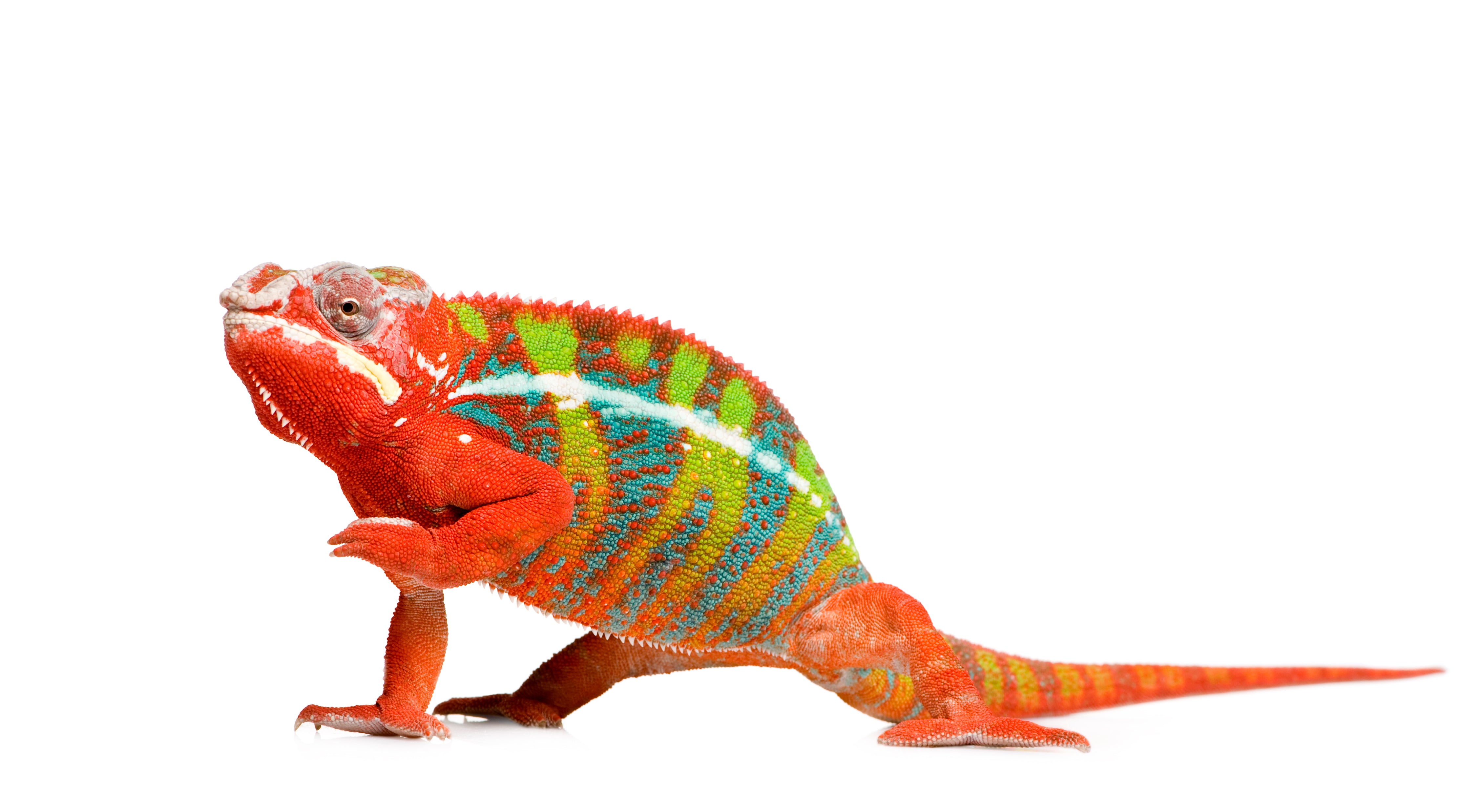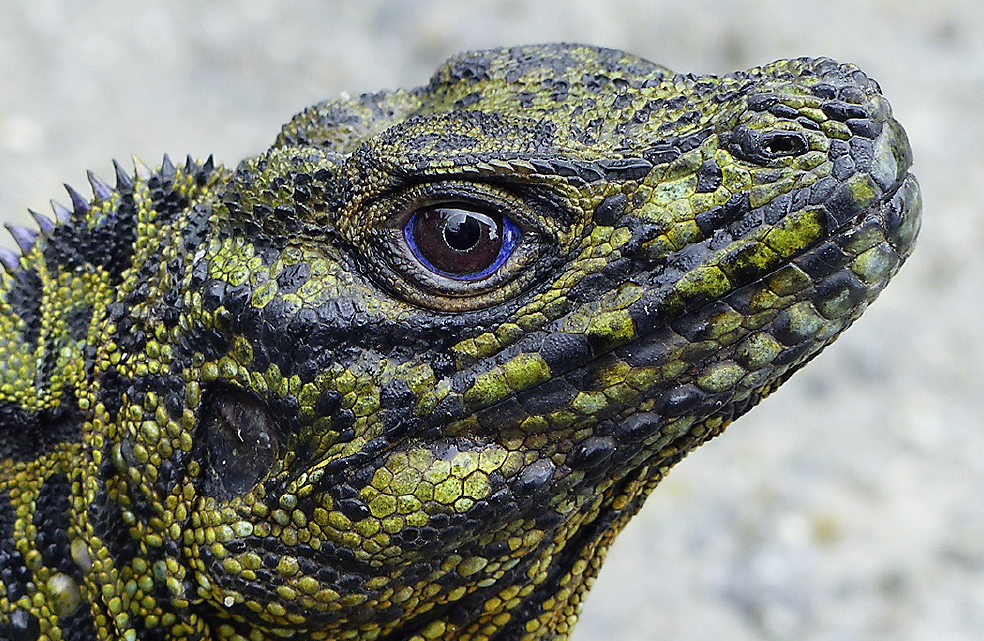Red eyed crocodile skinks (Tribolonotus gracilis) are 7-9” long terrestrial lizards native to New Guinea. They are crepuscular, which means that they are most active around dawn and dusk. Their preferred habitat is the damp, leaf-strewn floor of tropical forests, often near a body of water.
Red eyed crocodile skinks are well-known for their distinctive appearance. They are primarily black to dark brown in color, with bright orange around each eye. Their scales are bumpy and heavily keeled, featuring many backward-curving spikes.
Red eyed crocodile skinks are secretive reptiles that are sensitive to poor husbandry and prefer to avoid humans, which makes them an intermediate- to advanced-level pet reptile. With good care, they generally live 8-10 years.
How much space do red eyed crocodile skinks need?
A single red eyed crocodile skink should be housed in no smaller than a 30”L x 12”W x 12”H enclosure. Of course, larger is always better!
Cohabitation (keeping multiple red eyed crocodile skinks in the same terrarium) is generally not recommended unless you plan on breeding, in which case you will need a larger enclosure. Both males and females are territorial toward members of the same sex.
Do red eyed crocodile skinks need UVB?
They can survive without it, but it’s still recommended. UVB gives them all of the vitamin D that their bodies need, stimulates better appetite and activity, and generally allows them to be healthier than they would be without.
Red eyed crocodile skinks do best with low-strength UVB as part of their enclosure. The best UVB bulbs for red-eyed crocodile skinks housed in a 30” x 12” x 12” terrarium are:
The UVB bulb should be housed in a reflective Arcadia or Vivarium Electronics fixture and placed close to the heat lamp, about 6-9” above the basking branch. UVB is blocked by glass and plastic, so you can’t give your pet UVB by placing its terrarium in front of an open window. Also make sure that the fixture your UVB bulb is in does not have a clear plastic bulb cover.
UVB bulbs decay over time, so you will need to replace your bulb every 6-12 months (according to manufacturer instructions) to maintain performance.
Lights should be on for 12 hours/day.
What basking temperatures do red eyed crocodile skinks need?
Despite being “room temperature reptiles” at first glance, red eyed crocodile skinks DO benefit from having access to a basking area. After all, they’re still ectotherms, which means that they need a temperature gradient in their enclosure to help them regulate their metabolism and stay healthy.
Red eyed crocodile skinks should have a low basking surface temperature between 82-89°F, as measured by a digital probe thermometer with the probe placed on the basking surface. The cool zone on the other side of the enclosure should stay between 72-78°F. Heat lamps should be turned off at night. Nighttime temperatures can drop as low as 68°F.
Provide heat for your skink with a low-wattage heat lamp placed on one side of the enclosure. Do not use red bulbs, or blue bulbs, as these are not as effective. Lightless heat sources such as CHEs and DHPs can be used if night temps get too cold.
What humidity levels do red eyed crocodile skinks need?
Red eyed crocodile skinks are a tropical species, so they need fairly high humidity levels in their enclosure: 80-95%, and absolutely no lower than 70%.
Misting your lizard’s enclosure with a sprayer first thing in the morning and again at night will help create the right humidity levels. If you have difficulty maintaining high humidity levels, running a reptile humidifier at night can help. Make sure your skink has access to a humid hiding place at all times.
What substrate is good for red eyed crocodile skinks?
Although red eyed crocodile skinks don’t seem particularly inclined toward digging and burrowing, it’s still a good idea to provide at least 3-6” of substrate to help maintain healthy humidity levels. This is also a necessity if you plan to use live plants in the setup.
We recommend the following substrates for red eyed crocodile skinks:
Layering clean, chemical-free leaf litter on top of the substrate can also help with humidity and enhances the enclosure’s appearance.
Substrate should be completely replaced every 3-4 months. Remove poop and urates daily, along with any contaminated substrate.
What décor can you use in a red eyed crocodile skink terrarium?
It’s terribly boring for a reptile to be stuck in an enclosure with nothing in it except substrate and food/water bowls. It doesn’t matter how big the enclosure is if you don’t put things in it for your pet to use and interact with! Red eyed crocodile skinks tend to appreciate a fairly densely planted enclosure, which can make their terrarium a great piece of home décor!
Here are some ways you can decorate/enrich your skink’s environment:
What do red eyed crocodile skinks eat?
Red-eyed crocodile skinks are primarily insectivorous, which means that they need to eat insects (preferably live) in order to get the nutrition that their bodies need. Juveniles should be fed 2-3 insects daily, and adults should be fed the same amount every other day. Each insect should be roughly half the size of the skink’s head.
Feeder insects for red eyed crocodile skinks: dubia roaches, discoid roaches, red runner roaches, crickets, black soldier fly larvae, small hornworms, silkworms, mealworms, mealworm beetles, earthworms
Supplements
You will need calcium and vitamin supplements to help prevent your red eyed crocodile skink from developing a deficiency. We recommend Repashy Calcium Plus LoD, lightly dusted on all of your lizard’s feeder insects at every other feeding.
Water
Provide a medium-sized, shallow water bowl where your lizard can always get a drink and soak as needed. Change the water daily and scrub the bowl with a reptile-safe disinfectant weekly, or whenever it becomes soiled.
Do red eyed crocodile skinks like to be handled?
Few reptiles actually “like” to be held, and red eyed crocodile skinks are not one of them. Attempting to handle is very likely to cause excessive stress for your pet. Instead of interacting with your lizard by holding it, try hand-feeding it instead with a pair of soft-tipped feeding tweezers.




Leave a comment
This site is protected by hCaptcha and the hCaptcha Privacy Policy and Terms of Service apply.